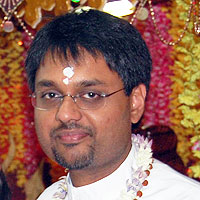From a satsang with Pt. Dr. Umesh Persad, Spiritual Leader, Shiva Shakti Mandir of Marion Oaks, Florida
It is essential to understand the purpose behind our religious rituals, such as performing havan and chanting mantras. Our physical actions can have profound impacts on each of us. Remember, our offerings are not for a distant deity; they symbolise the One Supreme principle known as God, the universe, Consciousness or Atman. Every religion aims to achieve unity with this supreme principle through contemplation, prayer and meditation. Why do we engage in these practices? They are for each individual’s spiritual journey.
Sanatan Dharma teaches that there is one Consciousness, one Supreme Spirit, which manifests as the myriad forms around us. Everything and everyone are expressions of this single reality. But do we truly perceive this oneness in our daily lives?
Consider the analogy of the ocean and its waves. The ocean, representing the totality of existence, is intangible and infinite, akin to Consciousness. Waves emerge from the ocean, powered by its energy, only to return to it. Similarly, each person is like a wave—arising for a time before merging back into the great whole. We must realise that our sense of individuality is an illusion. When we are in deep sleep, devoid of the ego’s chatter, we don’t feel like separate entities. This insight reveals the fleeting nature of our day-to-day perceptions, they are transient like passing clouds.
Sanatan Dharma offers various pathways to achieve this understanding, tailored to individual temperaments. Personal deities like Shree Raam, Krishna Bhagavan and Shivaji are representations of the one Supreme, viewed through our unique perspectives. But we must always remember the ultimate goal—realising the oneness of all existence.
When we pray, the subtle vibrations we create are not confined by physical boundaries; they resonate universally. The true essence of our practices lies in these vibrations, not in the physical objects like murtis or flowers. This is why sound—through bells, gongs and mantras—plays a crucial role in our rituals. The word “mantra” derives from “man” meaning mind, and “tra” meaning technique. Thus, a mantra is a technique for the mind, influencing our consciousness.
The mantra we chant, “Om Namah Shivaya,” venerates Shiva, who symbolises both stillness and movement. The ocean represents stillness, while waves signify movement. Shiva embodies both aspects, illustrating the dynamic interplay of the universe. “Om” represents the primal sound, the fundamental vibration that permeates everything.
“Om Namah Shivaya” is known as the Panchakshara Mantra, or the five-syllable mantra. It functions as a pump for our consciousness, energising the chakras within our bodies. These chakras, or spinning energy wheels, represent various states of consciousness. The mantra helps elevate this energy, guiding it from lower to higher states. This process is experiential, not merely physical.
As we chant “Om Namah Shivaya,” let us connect with this profound vibration, recognising its presence within us and all around us. Through this practice, we can advance towards the realisation of our true, unified nature.



